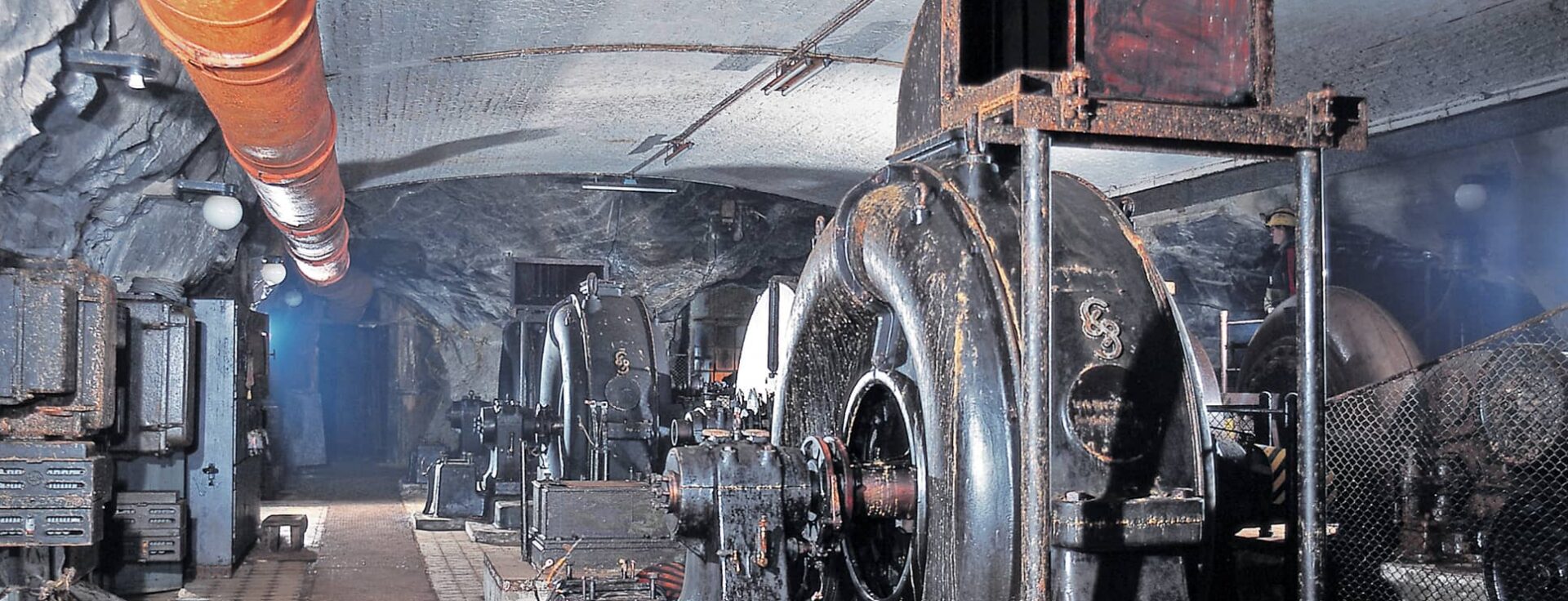Cavern power station


At the beginning of the 20th century, the global metallurgical market gained the upper hand, the price of silver fell worldwide, and the German state switched their currency to gold, which was more stable in value. All this meant that silver mining in Saxony was no longer economically viable. During the same period, a new main source of energy – electrical energy – made a breakthrough. Generators could convert mechanical energy into electrical energy. Turbine technology was so advanced that it could be used to drive the generators.
There was plenty of water in the area, not only in terms of quantity, but also with a usable head that is otherwise only found in alpine regions. What could be more obvious than to use these locational factors and thus give the region a new economic upswing?
Mining Councillor LANGE began to formulate initial ideas in 1904, at that time still under the premise of wanting to electrify the mining industry. However, economic developments soon overtook the idea of “electric mining”, and the hunger for energy of a region that had to reorganise itself industrially became apparent. Under this constellation, the legal foundations were quickly created so that, for example, mining water drainage could now also be used for the energetic utilisation of public property. In 1913, the final planning for a power plant was completed, which was ceremoniously put into operation on 24 December 1914.
Under current conditions, it would probably take several years to technically realise such an idea by examining all geological, ecological, legal and economic boundary conditions.
The water was used in two stages, see schematic diagram.
First, the water flowing in from the Hohebirker artificial channel was temporarily stored in an artificial pond. Via a penstock, the water from there reached two turbines 124 m below in the immediately neighbouring Constantin shaft, which drove their connected generators in the so-called “Oberwerks”. From the two Pelton turbines of the upper works, the water fell into the reservoir below. Since in ore mining, with a few exceptions, the mining cavities were not backfilled, in the area between Langenau and the Drei-Brüder-Schacht the sum of all these cavities could serve as an invisible reservoir above ground. So that the water could not flow away, underground dams were built (so-called “Verspünden”). All the cavities in the area above the Rothschönberger Stolln could hold about 1.5 million cubic metres. By way of comparison, that is about as much water as the Großhartmannsdorf pond contains.
The Rothschönberger Stolln served as the outflow of the dam after the water with a maximum dam height of 134 m had done its work a second time in the “substation” in the Drei-Brüder-Schacht. Here, in the final stage of expansion, stood three Pelton and one Francis spiral turbine with their generators.
This arrangement was capable of generating up to 5.5 MW of electrical energy. The electricity from the overhead power station was conducted via an underground cable to the control room on the Drei-Brüder-Schacht and from there fed into the overland grid. The power was supplied primarily to the towns of Brand-Erbisdorf, Langenau and Großhartmannsdorf with 27 larger companies, as well as the smelter in Muldenhütten and, from 1921, partly to Freiberg.
From 1948, with the resumption of mining, the operating mode of the power plant cascade had to be changed. The underground dam was no longer available. Now the water from above ground flowed successively through the headworks and the substation via a newly constructed cross-stream. The underground seepage water drained away unused via the Rothschönberger Stolln.
In 1953, the existing unit of water supply and power plant operation was split into VEB Energieversorgung and VEB Wasserwirtschaft. This resulted in quarrels over water supply and water prices. Politically, the energy policy was reoriented towards coal-fired power generation and Soviet oil. The GDR companies had to pay a so-called basic fund levy to the state for the facilities they used. The Rothschönberg mine, originally financed by the Kingdom of Saxony and the Freiberg mining industry, suddenly had to pay 11 million GDR marks again. The annual levy to be paid for this naturally had a considerable negative impact on the economic viability of the power plant. In 1968, it was decided to close the cavern power plant for reasons of (artificially created) uneconomical operation. As early as 1969, the upper plant went off the grid and was dismantled. The substation in the Three Brothers Shaft continued to run until 10 July 1972 with the seepage water entering the underground dam. Even the initiative of the power plant workers to operate the substation as a technical monument and thus preserve it went unheard.
The sensitive exciter machines were removed and taken to the surface. The technology remaining in the cavern was preserved in the hope of reactivation. With the cessation of cable travel in the Three Brothers Shaft, the technology in the cavern finally fell into a slumber.
In 1992, our association took over the care of this technical monument. Since 2017, the cavern has been accessible again via the newly extended Drei-Brüder-Schacht, which enables the association members to consider and implement new ideas, at least for the use of the seepage water.